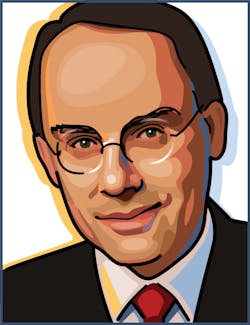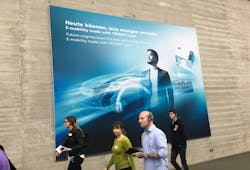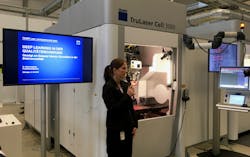Of course, digitization was a major topic. "If we measure ourselves against our expectations and against what we set ourselves three and a half years ago, then we are not as far as the goals were," Kammüller confessed right at the beginning. "The subject is much more complex than we had ever expected."
The company's plan was to make some 200 million Euro with digital solutions, but even after investments were doubled the amount of money made stands at about 20 to 30 million Euro. And it has not been a question of money: the company tripled its budget for IT investments and is willing to spend even more. "It is a staff problem," as Kammüller said. "We can't hire enough people for business IT.” A 50% staff increase has been not nearly enough; in addition, it takes time to cultivate team leaders.
Nevertheless, Trumpf has made a lot of progress, and sees itself as a technological leader among much larger players. As Kammüller explained, the company works on four areas of digital transformation: First, it standardizes and digitizes its own processes, and second, it has to make its products ready for digital workflows. This is something that was presented extensively in the show halls at Intech.
A third area is Axoom, Trumpf's platform for data and process management, while a fourth is related to marketplaces for services and products arising from digital processes. Trumpf wants to be there before a third party moves between itself and its customers.
So far, Trumpf has made substantial progress on all these fields. While introducing a digital workflow, the company has been able to increase the utilization of its machines from 30 to 70%—which, as Kammüller ironically added, would lead to a considerable gap in orders if all customers were to introduce it.
"The time has come to seize the opportunities offered by digitalization and new manufacturing technologies," said Kammüller. "It's not just big German companies, but also small and medium-sized ones that need to be asking themselves whether they are ready for the digitally connected future. If the answer is no, they need to embark on that process of transformation today." He noted that digitalization can be started at any point in time and is equally accessible to SMEs.
Working for tomorrow
Trumpf is a family business, even with a revenue of 3.6 billion Euro and more than 13.000 employees. And it is technology driven. One of the main drivers within the owner family is certainly CTO Peter Leibinger. He gave a review on their research and development projects, from quantum technology to artificial intelligence to some more down-to-earth projects including e-mobility and 3D printing.
"E-mobility is a great field for us, since many components can only be made by lasers," he said. Based on Trumpf's experience, for example in the manufacture of pacemakers, he sees Trumpf well-positioned for laser applications along the entire value chain. On the other hand, he has doubts concerning German initiatives to build battery factories: "80% of the manufacturing costs of a battery cell come from the material," he said, "and 20% added value is not enough for a classic German manufacturer."
Leibinger sees many more opportunities in 3D printing. He mentioned two trends: Upscaling to more productivity and bigger machines, and small solutions with much cheaper systems. For the latter, Trumpf is supporting a startup in autumn 2019 that plans to offer a radically simpler prototype.
Another forward-looking investment was the company's purchase of Philips’ laser-diode division last year. First, it serves as a second source for laser diodes, as Peter Leibinger unveiled. He estimated that about 50% of Trumpf's laser products depend on diodes from their facility in Princeton, NJ. In addition to the sourcing question, Leibinger sees the benefit of having a promising technology such as vertical-cavity surface-emittinglasers (VCSELs) on board. The use of VCSELs for distance sensors in smartphones is booming now, but they may be even more important for further industrial digitization procedures and Internet of Things (IoT) applications where sensors play a crucial role.
Last but not least, Trumpf was touting artificial intelligence (AI) for industrial applications. Across all departments Trumpf already has 40 people working on AI applications. At least one effort has already been introduced into manufacturing, where it helps in effectively releasing parts after laser cutting. In another project, the Trumpf developers taught their systems to listen to the machines, using vibration analysis on the different axes of their laser cutters to identify malfunctions.Trumpf is looking optimistically to the future. As a private company it does not publish quarterly revenues, but after some excellent previous years the company saw two-digit growth in the first half of its financial year. Kammüller expects a slowdown in growth numbers similar to those in the mechanical-engineering industry as a whole. After a seven-year-long upswing, Trumpf is experiencing a slowdown, but currently is still expecting considerable growth for the financial year 2018/19.



